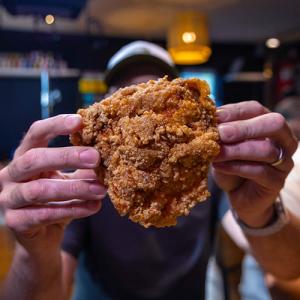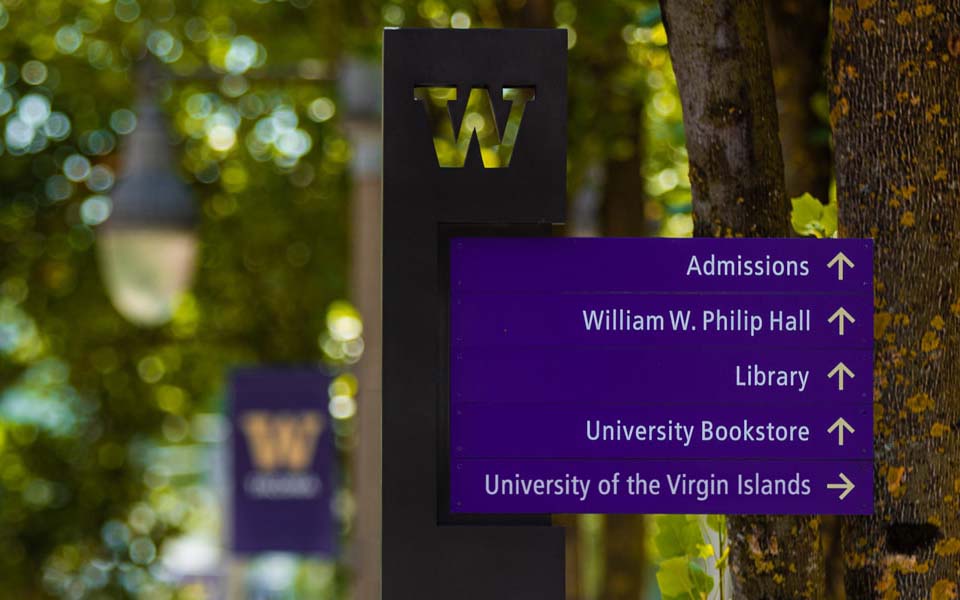
No One Is an Island
UW Tacoma Senior Lecturer Julie Masura and UW Tacoma alumna Catherine Crook came together to help a University of the Virgin Islands graduate student whose lab was destroyed by hurricanes.
UW Tacoma Senior Lecturer Julie Masura opened the “cold email”—think cold call but with email. The message was from a graduate student at the University of the Virgin Islands. “We created this protocol at UW Tacoma that’s being used all over the world to assess microplastics in environmental samples,” said Masura. “She had some questions about the protocol.”
Danielle Lasseigne grew up in Southern California. She earned a bachelor’s degree in marine biology and biological oceanography from California State University, Long Beach. Lasseigne moved to St. Thomas in the U.S. Virgin Islands to pursue a master’s degree in marine and environmental sciences. “I always knew I wanted to work around coral reefs and there are plenty of stateside schools that do research in tropical areas on coral reefs,” she said. “It just felt like it was easier to live where you do your research.”
Catherine Crook is busy. The UW Tacoma alumna is the GIS supervisor for the City of Kent. She supervises a team that looks at everything from traffic flow on a given street to runoff in different parts of the city. Crook earned a master’s in geospatial technologies and a bachelor’s in environmental studies at UW Tacoma. Masura and Crook met when the latter returned to campus to teach GIS for the professional program. They became friends. A few years ago, in the fall of 2017 the pair where having drinks together when Masura asked Crook a favor. “She wanted to know if Dani [Danielle] could stay with me,” said Crook. “I love Julie and would do pretty much anything she asked, so of course I said yes.”
Overcoming Distance
For her master’s thesis Lasseigne originally intended to study microplastics and whether or not they played a role in coral disease. “Within the territory there hadn’t been a lot of research on the amount of microplastics in the region,” she said. “My thesis focus shifted to examining microplastics in sediment associated with coral reefs.”
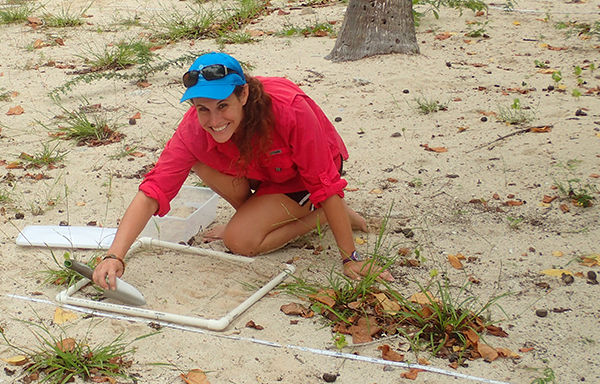
Lasseigne collected samples at different points around the island. At the same time she was investigating different methods used to process microplastics. “Julie published her work through NOAA [National Oceanic and Atmospheric Administration] and I found those and started asking her questions via email,” said Lasseigne.
The relationship between Masura and Lasseigne deepened over time. “While she [Lasseigne] was developing her research we would Skype and get to know each other,” said Masura. “During one of these conversations she asked me to be on her master’s committee which I happily accepted.”
The work proceeded. With Masura’s guidance, Lasseigne began processing her samples and would soon begin work on her thesis. Graduation may not have been within reach but it was within sight.
Irma & Maria
Life in the U.S. Virgin Islands isn’t that different than life in Tacoma. There are notable exceptions including the weather and scenery. “The water here is beautiful and warm,” said Lasseigne. “You can see how everything is connected.” There’s natural beauty but there are also car dealerships and fast food restaurants. The island’s major industry is tourism. “St. Thomas is the main island and gets all the cruise ships,” said Lasseigne. “There are days where we get six cruise ships coming into port and that adds thousands of people to an already overpopulated island.”
Lasseigne says the cliché about island life being more relaxed is generally true. “It’s not a bad thing to just stop in the middle of the sidewalk or sometimes in the middle of the road to talk to your friend.” This sense of community is helpful, especially in the aftermath of a hurricane.
The U.S. Virgin Islands is about 100 miles east of Puerto Rico in the Southern Atlantic Ocean. Hurricanes aren’t an everyday occurrence but neither are they rare. On average the region is affected by a hurricane about once every three years. In this definition, “affected” includes both indirect and direct hits.
With this context in mind, consider what happened in September 2017. During a two-week period the islands were rocked by two Category 5 hurricanes. Irma struck the U.S. Virgin Islands on September 6 and Maria made landfall September 20. The storms knocked out power and caused destruction on a scale that’s hard to fathom. U.S. Virgin Islands Congresswoman Stacy Plaskett estimated that 90% of the islands’ buildings sustained damage and 13,000 structures were left roofless.
Among the damaged buildings: Lasseigne’s lab. High winds blew out windows and twisted the structure off its original foundation. “There were a couple of days when I couldn’t get ahold of Dani and started to get concerned,” said Masura. “Finally, we connected over Skype and I could tell just by looking at her that she didn’t know what to do.”
Lasseigne had samples to process but no lab. Worse, there was no way of knowing when the lab would be functional again. “So Julie, without me asking, just offered to make space in her lab for me to work in,” said Lasseigne. “All I had to do was get there.”
Home Away from Home
Lasseigne landed at Sea-Tac Airport on November 1. The California native and resident of the U.S. Virgin Islands was used to sunshine and warm temperatures. Lasseigne came prepared. She made herself a coat for the stay in Washington. “There was one day where it was 65 degrees and I only had to wear a light sweater and jeans,” she said. “It was great.”
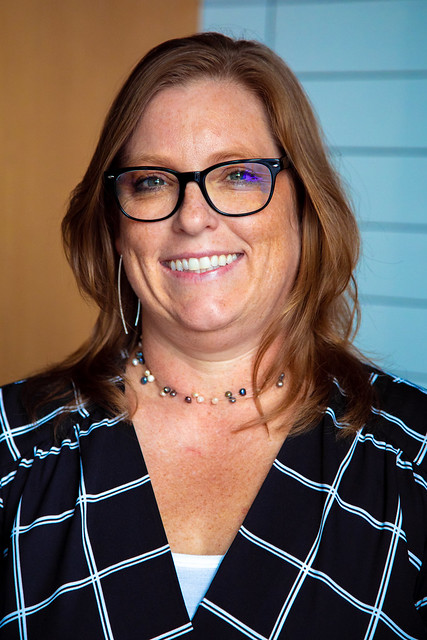
While in town, Lasseigne lived with Catherine Crook and her husband Vince. “Both of our sons had moved out and we had the space,” said Catherine Crook. The couple have a home in Brown’s Point. Masura lives about fifty miles from campus in Lynnwood which is one reason why she asked if Lasseigne could stay with the Crooks.
Lasseigne lived with the Crooks for six weeks. “Dani was wonderful,” said Catherine Crook. “It was almost like having a daughter.” The couple did more than just open up their home, they took care of Lasseigne in ways she needed at that moment. “They fed her dinner every night and would drive her to campus so she could do her work,” said Masura.
Lasseigne didn’t get to see much of Tacoma and the surrounding area during her visit. When she wasn’t at the Crooks, she was in Masura’s lab. “She had 24/7 access to the building,” said Masura. “My office is on the floor below so if she had a question she could just call or come down and visit.”
Lasseigne worked long hours that included evenings and weekends. Her life consisted mostly of beakers and microscopes but there were highlights. She had Thanksgiving with Masura at UW Tacoma Associate Professor Joyce Dinglasan-Panlilio’s house. Lasseigne participated in game night with the Crooks and was there during a big moment for the family. “One of my son’s asked his girlfriend to marry her,” said Crook. “Dani wasn’t there for the proposal but she did join us in the celebration afterwards.”
After the Storms
It’s been nearly two years since hurricanes Irma and Maria. Life on the U.S. Virgin Islands is slowly getting back to normal but there is still work to be done. Lasseigne finished her thesis and has since graduated. She now works as research technician at the University of the Virgin Islands. Lasseigne is currently involved with an effort to understand and stop the spread of a coral disease that has hit a local reef.
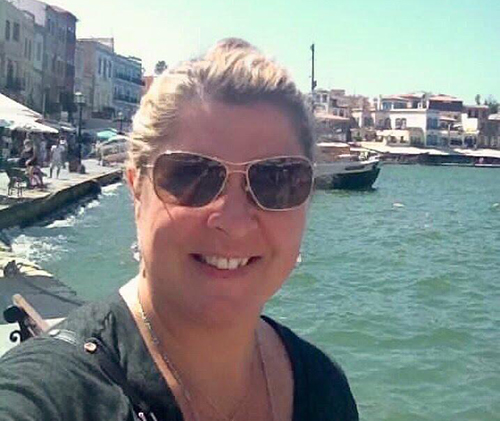
Lasseigne, Masura and Crook reunited in March of 2018. Lasseigne invited Masura to attend her thesis defense. The University of the Virgin Islands covered part of Masura’s expenses. Masura, in turn, asked Crook if she wanted to come along. The pair flew down to see Lasseigne and bear witness to the destruction caused by Irma and Maria. “Buildings at the university still had windows blown out and there was only one hotel open on St. Thomas,” said Masura.
Masura still talks to Lasseigne from time to time. The former is helping the latter get her thesis published in a peer-reviewed journal. Lasseigne and Crook don’t chat as often but that makes sense. Their connection was based on a need at a particular moment in time. After all, they’d only just met for the first time that gray day in November. Life gets in the way and distance makes it easier to drift but that doesn’t mean Lasseigne has forgotten. “I’m so grateful to Julie and to Catherine and Vince,” said Lassiegne. “They were truly amazing and without their support I don’t know where I’d be right now.”
Recent news
Main Content
Educated Palate
Main Content
Lawless Honored with Governor’s Student Civic Leadership Award
Main Content
Towards the Functional Characterization of All Human Genes
UW Tacoma in the News
Main Content
Minnesota adoptees respond to fraud reports in South Korean adoption programs
Main Content
What’s next for The Swiss? Upcoming workshop to tackle how to best use iconic site
Main Content
Local Leaders Recognized at UW Tacoma’s Business Leadership Awards
Contact Information
- Phone: 253-692-5880
- Email: uwturban@uw.edu
- Urban Studies, School of (directory)
